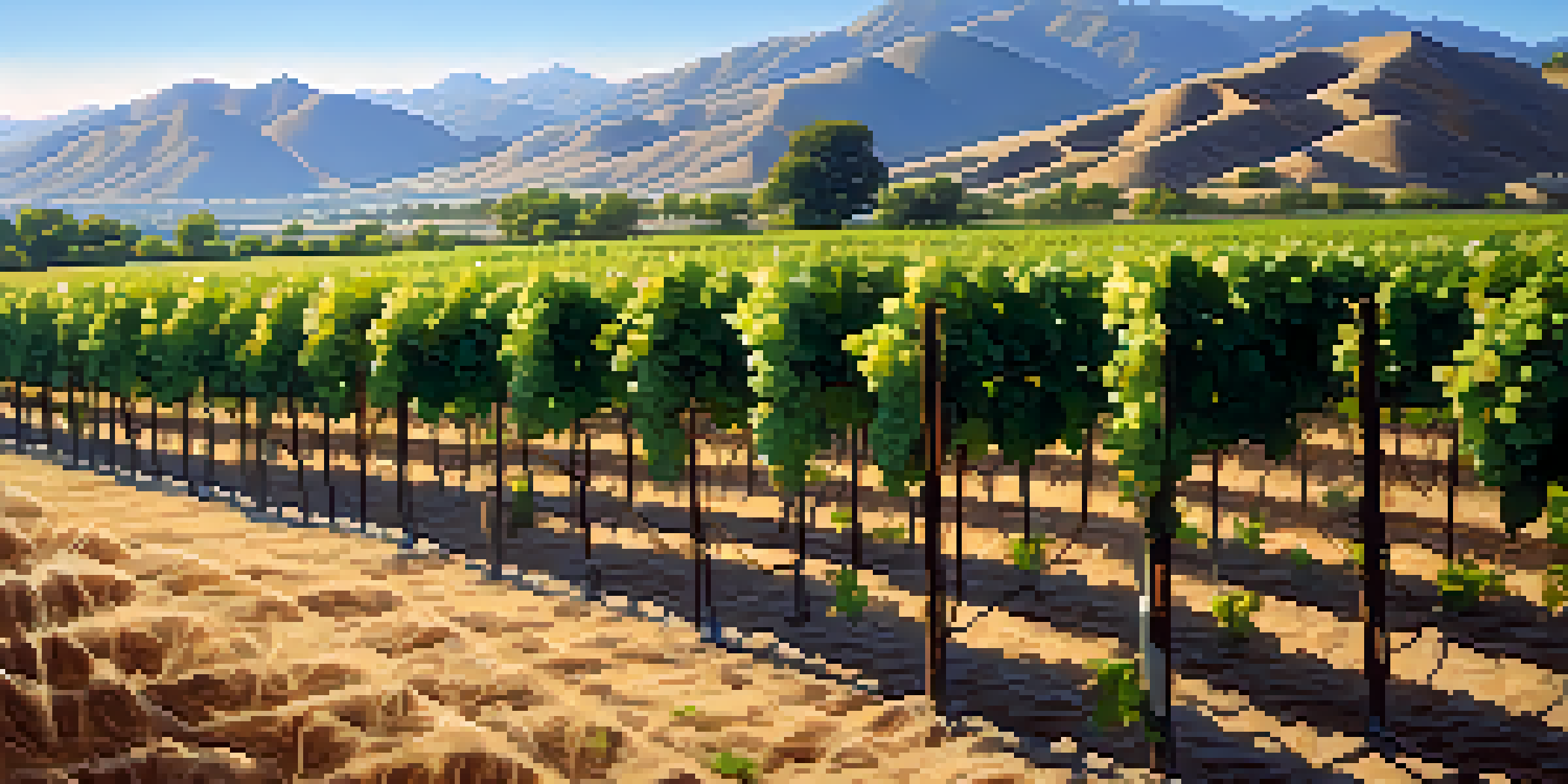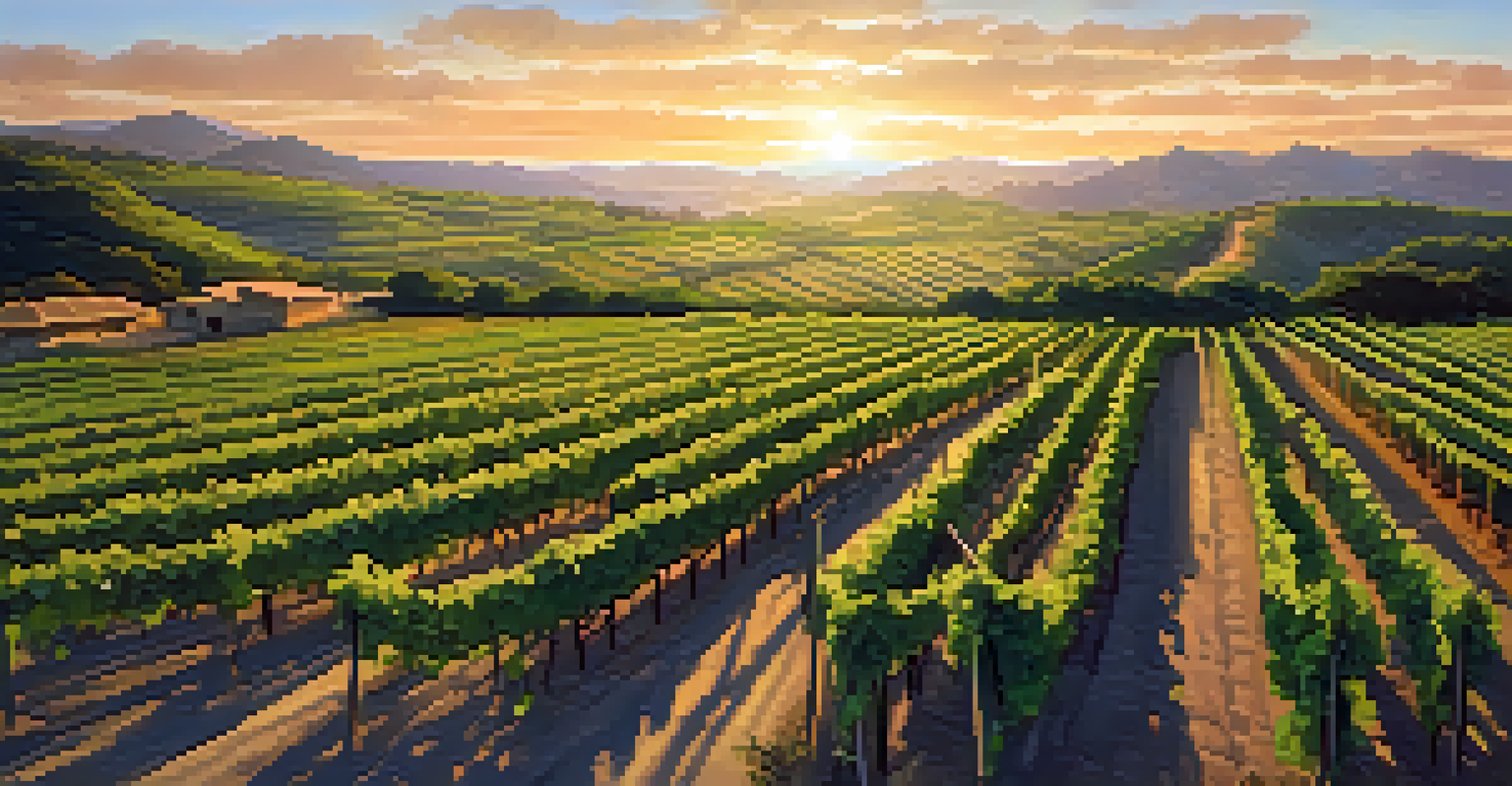Understanding the Terroir of Peru’s Wine-Producing Regions

What is Terroir and Why Does It Matter?
Terroir is a French term that refers to the unique environmental factors that affect a vineyard, including climate, soil, and topography. It’s often described as the 'taste of the place' and plays a crucial role in the character of the wine produced. When we talk about terroir, we’re really examining how these elements come together to create a wine that reflects its origin.
Wine is sunlight, held together by water.
Understanding terroir is essential for appreciating the complexity of wines. Just like how a dish can taste different depending on where the ingredients come from, wine is deeply influenced by its environment. This means that even small changes in soil composition or climate can lead to significant differences in flavor profiles, aromas, and overall quality.
In Peru, the concept of terroir is becoming increasingly important as the country gains recognition for its wine industry. By exploring the distinct terroirs across various regions, we can better understand what makes Peruvian wines unique and worth celebrating.
The Geographic Diversity of Peru
Peru's geography is incredibly varied, ranging from the high Andes mountains to the coastal desert and the lush Amazon rainforest. This diversity is a significant factor influencing the country's wine production, as different regions offer distinct climates and soil types. For instance, the cooler temperatures and higher altitudes of the Andes create an ideal environment for growing grape varieties like Malbec and Tannat.

Each region's geographic features contribute to the overall terroir, affecting factors like sunlight exposure, rainfall, and temperature fluctuations. For example, coastal vineyards benefit from fog and sea breezes that moderate temperatures, leading to a slower ripening process. This can enhance the development of flavors and aromas in the grapes.
Terroir Shapes Unique Wine Profiles
Terroir, encompassing climate, soil, and topography, plays a vital role in crafting wines that reflect their geographic origins.
Thus, as we explore Peru's wine regions, it's essential to appreciate how geography shapes not only the growing conditions but also the personality of the wines produced. Each bottle tells a story of its origin, deeply rooted in the land.
Exploring the Ica Region: A Wine Hotspot
The Ica region is often regarded as the heart of Peru's wine industry, thanks to its favorable climate and soil. Located south of Lima, Ica's warm temperatures and dry conditions create ideal conditions for grape cultivation. The region is particularly famous for its production of Pisco, but it also produces remarkable wines, especially from the Quebranta and Torontel grape varieties.
The best wines are the ones we drink with friends.
The sandy, well-draining soils of Ica contribute to the unique flavor profiles of its wines. The vines thrive here, benefiting from the intense sun during the day and cooler nights, which helps preserve the acidity and freshness in the grapes. This climate allows winemakers to craft wines that are both rich and balanced.
Moreover, Ica's winemakers are increasingly embracing innovative techniques and sustainable practices, further enhancing the quality of their wines. This blend of tradition and modernity is what makes Ica a must-visit destination for wine enthusiasts.
The Role of Altitude in Wine Quality
In Peru, altitude plays a significant role in defining the terroir, particularly in regions like Arequipa and Cusco. Vineyards situated at high elevations benefit from cooler temperatures and greater sunlight exposure, which can lead to more concentrated flavors and aromas in the grapes. This is why many Peruvian wines are known for their bright acidity and intense fruit character.
For example, vineyards in the high-altitude areas of the Andes can reach elevations of over 3,000 meters (about 9,800 feet). At these heights, the temperature difference between day and night is pronounced, allowing grapes to develop complex flavors while retaining freshness. This unique climate gives Peruvian wines a distinctive profile that sets them apart from those produced at lower altitudes.
Ica: Heart of Peru's Wine Industry
The Ica region, known for its favorable climate and innovative winemaking practices, is central to Peru's burgeoning wine scene.
Furthermore, high-altitude viticulture presents challenges, such as increased UV radiation and lower oxygen levels, which require winemakers to adapt their techniques. The result is a collection of wines that not only reflect their origins but also showcase the resilience and ingenuity of the producers.
Soil Types: The Foundation of Flavor
Soil composition is a critical aspect of terroir that significantly influences wine flavor. In Peru, the variety of soil types—from sandy loams in Ica to rocky soils in the Andes—contributes to the complexity of the wines produced. For instance, the mineral-rich soils found in high-altitude regions can impart unique flavors and aromas to the grapes, enhancing the overall wine experience.
Different grape varieties thrive in different soil types, which is why understanding the soil is essential for optimal grape cultivation. For example, Malbec often flourishes in well-drained soils, producing bold and rich wines, while white varietals like Sauvignon Blanc can benefit from soils that retain moisture to enhance freshness.
As winemakers continue to experiment with various grape varieties and vineyard locations, the interplay between soil and vine becomes more apparent. This exploration allows them to craft wines that are not only delicious but also deeply connected to their origins.
Climate and Its Impact on Grape Development
Climate is another key factor that shapes the terroir of Peru's wine regions. The country's diverse climatic conditions—from the arid coastal areas to the humid Amazon—result in variations in grape ripening and development. For instance, the warm, sunny days of Ica lead to ripe, fruit-forward wines, while cooler regions may produce more delicate and nuanced flavors.
Moreover, climate change is beginning to affect wine production worldwide, and Peru is no exception. Changes in temperature and precipitation patterns can alter growing seasons and grape quality. Winemakers are adapting by selecting grape varieties better suited to shifting climatic conditions, ensuring the continued success of their vineyards.
Sustainability in Winemaking Practices
Peruvian winemakers are increasingly adopting sustainable practices to enhance wine quality while preserving the environment for future generations.
By understanding the impact of climate on grape development, we can appreciate the nuances of Peruvian wines even more. Each bottle reflects not just the skill of the winemaker but also the unique climate conditions of the year it was produced.
Sustainability Practices in Peruvian Winemaking
Sustainability is becoming a priority for many Peruvian winemakers, as they recognize the importance of preserving the environment for future generations. This commitment to sustainability includes implementing organic farming practices, reducing water usage, and promoting biodiversity in vineyards. By taking these steps, winemakers are not only improving the health of their vines but also the quality of their wines.
For instance, some vineyards are adopting agroecological practices, which focus on working with nature rather than against it. This approach can lead to healthier soils, better grape quality, and ultimately, more exceptional wines. Additionally, many producers are exploring renewable energy sources to power their operations, reducing their carbon footprint.

As consumers become more aware of the importance of sustainability, the demand for environmentally friendly wines is growing. Peruvian winemakers are embracing this trend, showcasing their commitment to quality and the environment through their innovative practices.